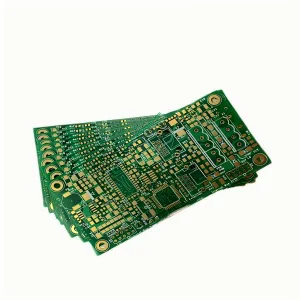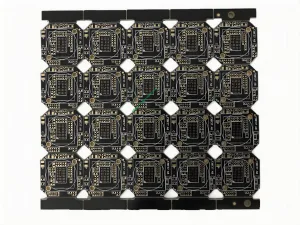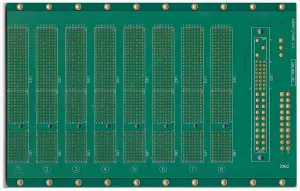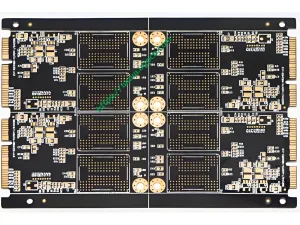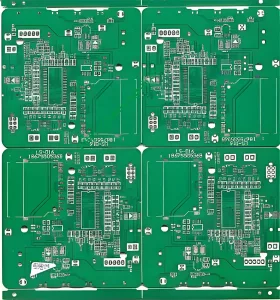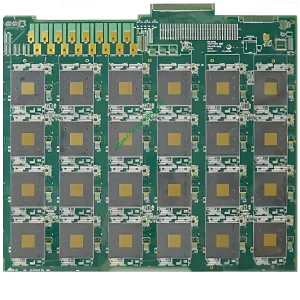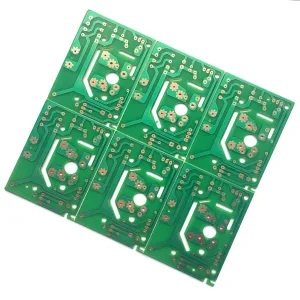Enig Immersion Gold process has the advantages of high flatness, uniformity, solderability and corrosion resistance, and is widely used in PCB surface treatment process of various electronic products.
ENIG is also called Immersion Gold. The chemical nickel content in PCB is generally controlled at 7-9% (medium phosphorus). The chemical nickel phosphorus content is divided into low phosphorus (matt), medium phosphorus (semi gloss) and high phosphorus (bright). The higher the phosphorus content, the stronger the acid corrosion resistance. Chemical nickel is divided into chemical nickel on copper, chemical nickel on copper and chemical nickel palladium processes. Common problems of chemical nickel are “black pad” (often called black disc, the nickel layer is corroded to be gray or black, which is not conducive to solderability) oder “mud crack” (fracture). The gold in enig can be divided into thin gold (replacement gold, thickness of 1-5u ″) and thick gold (reducing gold, thickness of enig can reach more than 25 microinches and the gold surface is not red). UGPCB mainly produces Enig thin gold PCB.
Process flow of Enig Immersion Gold PCB
Pre-treatment (brushing and sandblasting) – acid degreaser – Double wash – micro-etch (sodium persulfate sulfate) – Double wash – preimmersion (sulfuric acid) – activation (Pd catalyst) – pure water wash – acid wash (sulfuric acid) – pure water wash – chemical nickel (Ni/P) – pure water wash – chemical gold recovery – pure water wash – super pure hot water wash dryer
ENIG Immes Gold PCB and key process control
1. Remove oil cylinder
PCB nickelized gold is usually used for pre -treatment of acidic oil removal agents. Its role is to remove mild oil and oxides of copper surfaces, achieve the purpose of cleaning and increased wetting effect. Easy to clean the board.
2. Microlytic cylinder (SPS+H2SO4)
The purpose of slight erosion is to remove the residual residue of the copper surface oxidation layer and the pre -process, maintain fresh copper surface and increase the closeness of the chemical nickel layer. The micro -etching liquid is acidic sodium sulfate solution (NA2S2O8: 80 ~ 120g/L; sulfuric acid: sulfuric acid: 20 ~ 30ml/L). Because copper ions have a greater effect on the micro -eroding rate (the higher the copper ion, the more copper surface oxidation will be accelerated. The depth is 0.5 Zu 1.0 μm. When changing the cylinder, it often retains 1/5 cylinder parent liquid (old liquid) to maintain a certain copper ion concentration.
3. Pre -immersion cylinder
The pre -immersed cylinder only maintains the acidity of the activated cylinder and enters the active cylinder under the fresh state (anaoamide) under the fresh state (anaerobic). The pre -immersed cylinder of sulfate is used as a pre -immersed agent. The concentration is consistent with the activated cylinder.
4. Activated cylinder
The role of activation is a layer of palladium (PD) on the copper surface as a catalytic crystal nucleus for the starting reaction of chemical nickel. Its formation process is the chemical replacement reaction of PD and CU, and the copper surface is replaced with a layer of Pd. Tatsächlich, it is impossible to completely activate the copper surface (completely cover the copper surface). In terms of cost, this will increase the consumption of PD and easily cause serious quality problems such as seepage and nickel throwing nickel.
Attachment: When a gray -black sediment appears in the groove wall and the bottom of the groove, the nitric slot is required. The process is: 1: 1 nitric acid, start the cycle pump for more than 2 hours or until the gray black sediment of the slot wall is completely removed.
5. Nickel sinking cylinder (nickel -sinking reaction)
Chemical nickel is a catalytic effect of PD. NAH2PO2 hydrolyze generates atomic H. Gleichzeitig, under the conditions of PD catalytic conditions, the H atom is restored to a single nickel and deposited on the naked copper surface (generally nickel thickness is 100-250U, the rate rate is generally, the rate is the rate, and the rate is the rate. Control at 6-8 μl).
Chemical nickel slot nitrate trough procedures: draw chemical nickel potion into a spare slot. The concentration of commercially available concentration is 65%, nitric acid with a nitrate concentration of 10-30%(V/V), open the filtration cycle or pose for at least 8 hours after at least 8 Std.. After a few hours of static, check the bottom of the slot or the slot wall to be nitrated? If you do n’t clean it, you need to supplement the nitric acid until the nitrate is clean. After the nitrics are clean, you need to remove the nitric acid waste liquid and rinse it with water, and then open the tank with water for about 15 Minuten (at least twice). And turn on the circular filtration for 15 Minuten, and check the water, pure water pH value (test strip or pH test) data in the tank (generally the pH value of pure water was washed between 5-7) and the conductivity (generally at 15US/ Below cm) is qualified.
6. ENIG cylinder (sinking gold replacement reaction)
The replacement reaction Immersion Gold can usually reach the limit thickness for 30 Minuten (generally the gold thickness is 0.025-0.1 μm), and the rate is controlled at 0.25-0.45 μm/min). Due to the low content of Immersion Gold liquid AU (generally 0.5-2.0g/L), the diffusion speed and inner layer distribution of the PCB sinking gold solution affect each other Difference. Allgemein gesprochen, it is normal to be 100%higher than the gold thickness of the large area of PAD. Shen Jin’s thickness requirements can control the gold thickness by regulating temperature, time or increased gold concentration. The larger the golden cylinder, desto besser, not only the small changes in the AU concentration are conducive to the control of the gold thickness and can extend the cylinder cycle.
Precautions for ENIG Immes Gold PCB Manufacturing
1. When the dense spacing of soft board lines is less than 0.1 mm, the activation time should be controlled between 60~90 seconds, and Pd2+should be controlled between 10~15PPM. If nickel cannot be deposited, or there is a small piece in a board or a thin gold deposit on the circuit, it indicates that the activation concentration or time is insufficient.
2. The test plate was degreased, micro etched, pre dipped and activated. After the activation treatment, the Pd layer on the Cu surface was observed: the surface was grayish white with moderate activation (neither too much activation turned black, nor too little activation turned the color of Cu), and then nickel gold was melted without missing plating and infiltration, indicating that the activator had good selectivity.
3. Check whether the anode protection voltage is normal before production. If it is abnormal, check the cause. The normal voltage protection is 0.8~1.2V;
4. Before production, 0.3~0.5dm2/L bare copper clad plate must be used to start plating nickel bath. During production, the load shall be between 0.3~0.8dm2/L. If the load is insufficient, the drag cylinder plate shall be added. The voltage of the anti cathode precipitation device is set at 0.9 V. When the current exceeds 0.8 A, the tank will be turned over, and the joints should be checked regularly.
5. The cylinder shall be dragged half an hour in advance to ensure the normal activity and parameters. After the line is stopped, the nickel bath temperature drops below 60 ℃. During heating, circulation or air mixing shall be started. During production, air agitation shall be enabled in the heating area of nickel bath, and the area for plate laying shall be free from air agitation;
6. Nickel gold plating on non conductive holes: too much palladium remains in direct electroplating or chemical copper, and the nickel bath activity is too high. If hydrochloric acid+thiourea is used, the composition of the solution: thiourea 20~30g/L, analytical pure hydrochloric acid 10~50ml/L, and acid degreaser 1ml/L. Operating conditions: 4~5 minutes; The temperature is 22~28 ℃, the sodium persulfate is slightly etched 80 g/L, and the sulfuric acid is 20~50 ml/L. Another method is to dip the solution after etching (sulfuric acid: 100ml/L+thiourea: 20g/L+stannous sulfate: 60g/L), and then remove tin, Go through three countercurrent water washing and then go through the whole nickel gold melting line or the process is blue loading → soaking in thiourea (swing) → water washing (once) → unloading the plate (pay attention not to scratch) → placing it in a basin filled with clean water (not in the air) → passing through the brush mill → the first micro corrosion spraying → water spraying → no need to grind the plate → air drying → loading the plate → normalizing nickel gold.
7. If the nickel deposition rate is ≥ 4MTO (the supplement amount is greater than the multiple of the cylinder opening amount), the nickel deposition rate will slow down with the increase of MTO, the gold deposition rate will slow down due to the surface activity of the nickel layer, and the plate after gold deposition will be dark. The gilding time shall be long. If the gilding liquid is replaced, the appearance shall be normal. If it is nickel or gold bath is polluted, and the activity is poor when it passes through the nickel gold bath, the gold loading rate is slow and it is difficult to deposit gold or the gold surface is colorless. Zusätzlich, the gold surface is light white, not yellow, and slightly inferior. There are grey holes in the nickel plating plate when it comes out from the gold plating normally, and the activity of the gold bath is usually insufficient (Notiz: the gold layer is darkened due to organic pollution, the gold content is increased or the gold deposited for a longer time is not yellow).
8. If the nickel sink contains high phosphite (the nickel sink is gray), the nickel deposition thickness will remain unchanged (no reaction) for a long time. Allgemein, the content of sodium phosphite (NaHPO3) is controlled at<120g/l. If it reaches ≥ 120g/l, new solution shall be prepared.
9. Nickel plating missing and whitening – das heißt, a thin layer of nickel has been deposited and the nickel layer is white. It can be seen from this that the bath solution in the nickel bath has poor activity. The method is to drag the tank and add agent D to activate the activity of the nickel bath solution.
10. Withdraw the nickel gold insert and remove it with nitric acid+hydrochloric acid.
11. If the nickel deposit is black (stain), the rate of gold deposition becomes slower at this time, then the gold surface from the deposit is red and yellow (red and oxidized).
12. The higher the pH value of nickel solution, the lower the phosphorus content. The higher the MTO is, the higher the PH value should be and the slower the precipitation rate should be.
13. The gold bath solution has low gold concentration and long service life or is not clean after washing (easy to cause gold oxidation). The liquid medicine has a long service life and high impurities (the gold surface is speckled).
14. When the gold is thin, it can be reworked. The rework method is: pickling (1-2 Minuten) → water washing (1-2 Minuten) → gold precipitation.
15. The boards should be dried within half an hour after gold deposition. The boards should be separated by white paper of appropriate size. The board holder must wear anti-static gloves. Nach dem Trocknen, the boards shall be transported to the board inspection room within 30 minutes to avoid gold oxidation caused by acid mist.
16. When the gold concentration in the gold precipitation tank is low and polluted by nickel, copper and metal impurities, the deposition rate will decrease (the activity will become poor) and even it is difficult to deposit gold (the gold precipitation time is long and the thickness cannot meet the requirements).
17. The working temperature of the solution must be kept fluctuating at about 2 ℃. If the amplitude is too large, flake coating will be produced.
18. The line shall be stopped for less than 8 hours for the nickel bath, and the cylinder shall be towed for 10-20 Minuten, and the line shall be stopped for more than 8 Std., and the cylinder shall be towed for 20-30 Minuten.
19. During production, air agitation shall be enabled in the nickel bath heating area.
20. Large load: rough, poor nickel deposition (spontaneous decomposition, rough nickel layer), and easy decomposition failure.
21. When Ni2+in the gold bath exceeds 500ppm, the appearance and adhesion of the metal will become worse, and the liquid medicine will turn green slowly. Zu diesem Zeitpunkt, the gold bath must be replaced, which is very sensitive to copper ions. Der Niederschlag von mehr als 20 ppm wird verlangsamt und zu erhöhtem Stress führen. Nach Nickelniederschlag, Es sollte nicht lange übrig bleiben, um eine Passivierung zu vermeiden.
Die Ursachenanalyse häufiger Probleme bei Nickelgold und die entsprechenden Verbesserungsmaßnahmen sind nur aufgeführt. Nur durch ständiges Lernen und Zusammenfassen können wir die Produkttechnologie gründlicher beherrschen. Nur mit umfangreicher Erfahrung können wir das Problem besser analysieren und bestimmen. Gleichzeitig, Wir können die flüssige Medizin effizienter kontrollieren und aufrechterhalten, wissenschaftlich, Flexibel und effektiv, und wirklich eine hohe Effektivität zu erreichen. Verbessern Sie die Produktgewinnspanne auf der Grundlage hoher Qualität und reduzieren Sie die Verschwendung von Ressourcen!
 UGPCB-LOGO
UGPCB-LOGO


